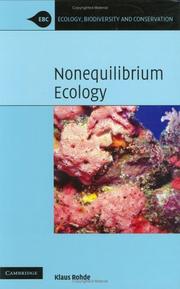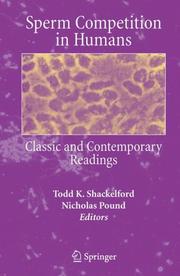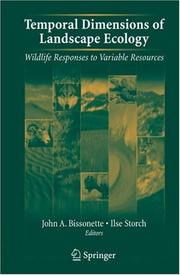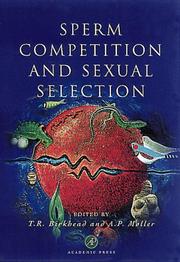| Listing 1 - 10 of 11 | << page >> |
Sort by
|
Book
ISBN: 1789843421 1789843413 1838815538 Year: 2018 Publisher: [London] : IntechOpen,
Abstract | Keywords | Export | Availability | Bookmark
 Loading...
Loading...Choose an application
- Reference Manager
- EndNote
- RefWorks (Direct export to RefWorks)
In the coming years, farmers will face difficult challenges throughout the world in terms of climate change, water scarcity, and environmental issues caused by conventional agricultural technologies. Effective management of natural resources can be encouraged by orienting the common agricultural practices towards the functional biodiversity concept in designing and implementing sustainable and eco-friendly cropping systems. In the framework of polycrop science, this book provides basic principles and several case studies of polycrop utilization in various regions of the world as a method of functional biodiversity amplification through species associations that maximize the productivity per unit of land area, suppress the growth and development of weeds, and reduce the amount of harmful pests and insects.
Plant competition. --- Competition (Biology) --- Plant ecology --- Life Sciences --- Agronomy --- Agricultural and Biological Sciences --- Agroecology
Book
ISBN: 0691084068 0691628904 0691611149 1400886147 9781400886142 0691081484 9780691081489 9780691084060 Year: 2017 Publisher: Princeton, NJ
Abstract | Keywords | Export | Availability | Bookmark
 Loading...
Loading...Choose an application
- Reference Manager
- EndNote
- RefWorks (Direct export to RefWorks)
Eric Pianka offers a synthesis of his life's work on the comparative ecology of lizard assemblages in the Great Basin. Mojave and Sonoran deserts of western North America, the Kalahari semi-desert of southern Africa, and the Great Victoria desert of Western Australia.Originally published in 1986.The Princeton Legacy Library uses the latest print-on-demand technology to again make available previously out-of-print books from the distinguished backlist of Princeton University Press. These editions preserve the original texts of these important books while presenting them in durable paperback and hardcover editions. The goal of the Princeton Legacy Library is to vastly increase access to the rich scholarly heritage found in the thousands of books published by Princeton University Press since its founding in 1905.
Lizards --- Desert animals --- Niche (Ecology) --- Biotic communities. --- Reptiles --- Herpetofauna --- Herpetozoa --- Herps --- Herptiles --- Reptilia --- Sauria --- Amniotes --- Vertebrates --- Herpetology --- Biocenoses --- Biocoenoses --- Biogeoecology --- Biological communities --- Biomes --- Biotic community ecology --- Communities, Biotic --- Community ecology, Biotic --- Ecological communities --- Ecosystems --- Natural communities --- Ecology --- Population biology --- Microhabitat --- Biotic communities --- Competition (Biology) --- Habitat (Ecology) --- Desert fauna --- Arid regions animals --- Desert biology --- Lacertilia --- Lacertilian reptiles --- Lacertilians --- Squamata --- Ecology.

ISBN: 9780511542152 9780521854344 9780521674553 0511137559 9780511137556 0511133979 9780511133978 0511542151 9780511135385 0511135386 0521854342 0521674557 1107155037 9781107155039 1280431768 9781280431760 9786610431762 6610431760 0511183682 9780511183683 0511201753 9780511201752 0511311869 9780511311864 Year: 2005 Publisher: Cambridge, UK New York Cambridge University Press
Abstract | Keywords | Export | Availability | Bookmark
 Loading...
Loading...Choose an application
- Reference Manager
- EndNote
- RefWorks (Direct export to RefWorks)
Ecology has long been shaped by ideas that stress the sharing of resources and the competition for those resources, and by the assumption that populations and communities typically exist under equilibrium conditions in habitats saturated with both individuals and species. However, much evidence contradicts these assumptions and it is likely that nonequilibrium is much more widespread than might be expected. This book is unique in focusing on nonequilibrium aspects of ecology, providing evidence for nonequilibrium and equilibrium in populations (and metapopulations), in extant communities and in ecological systems over evolutionary time, including nonequilibrium due to recent and present mass extinctions. The assumption that competition is of overriding importance is central to equilibrium ecology, and much space is devoted to its discussion. As communities of some taxa appear to be shaped more by competition than others, an attempt is made to find an explanation for these differences.
Ecology. --- Competition (Biology) --- Biotic competition --- Ecological competition --- Interspecific competition --- Intraspecific competition --- Species competition --- Struggle for survival (Biology) --- Survival, Struggle for (Biology) --- Population biology --- Species --- Balance of nature --- Biology --- Bionomics --- Ecological processes --- Ecological science --- Ecological sciences --- Environment --- Environmental biology --- Oecology --- Environmental sciences --- Ecology
Book
ISBN: 128059456X 9786613624390 0191628018 9780191628016 9780199587100 0199587108 9780199587117 0199587116 0191628026 Year: 2012 Publisher: Oxford University press
Abstract | Keywords | Export | Availability | Bookmark
 Loading...
Loading...Choose an application
- Reference Manager
- EndNote
- RefWorks (Direct export to RefWorks)
The origin of biological diversity, via the formation of new species, can be inextricably linked to adaptation to the ecological environment. Specifically, ecological processes are central to the formation of new species when barriers to gene flow (reproductive isolation) evolve between populations as a result of ecologically-based divergent natural selection. This process of 'ecological speciation' has seen a large body of particularly focused research in the last 10-15 years, anda review and synthesis of the theoretical and empirical literature is now timely.The book begins by clarifying wha
Evolution. --- Species. --- Symbiogenesis. --- Biodiversity --- Evolution (Biology) --- Isolating mechanisms --- Niche (Ecology) --- Species --- Speciation (Biology) --- Biology --- Genetics --- Hybridization --- Organisms --- Microhabitat --- Biotic communities --- Competition (Biology) --- Ecology --- Habitat (Ecology) --- Isolation, Biotic --- Isolation mechanisms --- Reproductive isolation mechanisms --- Reproduction --- Animal evolution --- Animals --- Biological evolution --- Darwinism --- Evolutionary biology --- Evolutionary science --- Origin of species --- Evolution --- Biological fitness --- Homoplasy --- Natural selection --- Phylogeny --- Biological diversification --- Biological diversity --- Biotic diversity --- Diversification, Biological --- Diversity, Biological --- Biocomplexity --- Ecological heterogeneity --- Numbers of species --- Isolating mechanisms. --- Biodiversity.

ISBN: 1280634308 9786610634309 0387280391 0387280367 Year: 2006 Publisher: New York, NY : Springer,
Abstract | Keywords | Export | Availability | Bookmark
 Loading...
Loading...Choose an application
- Reference Manager
- EndNote
- RefWorks (Direct export to RefWorks)
Over the past decade, there has been a vast amount of interest in the subject of human sperm competition. This volume brings together, in one place, a key set of classic and contemporary papers that have examined possible adaptations to sperm competition in humans. In addition to classic papers by Robin Baker & Mark Bellis, it includes later work by other researchers – some developing their ideas, some refuting their findings. As is to be expected in any comparatively new area of investigation, there are conflicting findings and unresolved issues. This, however, should encourage rather than discourage future research in this field. This collection of papers is essential reading for students of evolutionary biology, evolutionary psychology, human sexuality and researchers considering conducting work in this area. .
Sperm competition. --- Inter-ejaculate competition --- Competition (Biology) --- Sexual selection in animals --- Evolution (Biology). --- Animal behavior. --- Ecology. --- Anthropology. --- Reproductive Medicine. --- Evolutionary Biology. --- Behavioral Sciences. --- Human reproduction --- Human reproductive health --- Human reproductive medicine --- Reproductive medicine --- Health --- Human beings --- Balance of nature --- Biology --- Bionomics --- Ecological processes --- Ecological science --- Ecological sciences --- Environment --- Environmental biology --- Oecology --- Environmental sciences --- Population biology --- Animals --- Animals, Habits and behavior of --- Behavior, Animal --- Ethology --- Animal psychology --- Zoology --- Ethologists --- Psychology, Comparative --- Animal evolution --- Biological evolution --- Darwinism --- Evolutionary biology --- Evolutionary science --- Origin of species --- Evolution --- Biological fitness --- Homoplasy --- Natural selection --- Phylogeny --- Health aspects --- Ecology --- Behavior --- Evolutionary biology. --- Behavioral sciences. --- Ecology . --- Reproductive medicine. --- Primitive societies --- Social sciences

ISBN: 9786611043292 128104329X 0387454470 0387454454 0387454446 Year: 2007 Publisher: New York, N.Y. : Springer,
Abstract | Keywords | Export | Availability | Bookmark
 Loading...
Loading...Choose an application
- Reference Manager
- EndNote
- RefWorks (Direct export to RefWorks)
Over the past twenty-five years, the effects of the spatial distribution and scaling of resources on animal populations have been increasingly studied in wildlife biology, landscape ecology, conservation biology, and related fields. However, spatial patterns change over time. In Temporal Dimensions of Landscape Ecology: Wildlife Responses to Variable Resources, the authors discuss the effects that temporal changes in resources have on animal populations. Resource availability and quality are not distributed homogeneously over time, depending for example on predictable changes in seasons, mating and birthing cycles, unpredictable resource pulses and weather-related phenomena, ecological disturbances, and historical legacies. Temporal Dimensions of Landscape Ecology brings together chapters that address the idea of current as well as historical temporal influences on resource availability, quality, and distribution. The authors draw attention to the neglected temporal issues so important to understanding species and community responses. This book will be of interest to both wildlife and conservation students and practitioners working with temporal and spatial scale issues.
Landscape ecology. --- Niche (Ecology) --- Adaptation (Biology) --- Spatial ecology. --- Chronobiology. --- Ecology --- Biological time --- Biology --- Time --- Environment --- Self-organizing systems --- Variation (Biology) --- Biological fitness --- Genetics --- Microhabitat --- Biotic communities --- Competition (Biology) --- Habitat (Ecology) --- Ecology. --- Animal ecology. --- Endangered ecosystems. --- Environmental management. --- Landscape Ecology. --- Animal Ecology. --- Ecosystems. --- Community & Population Ecology. --- Environmental Management. --- Environmental stewardship --- Stewardship, Environmental --- Environmental sciences --- Management --- Threatened ecosystems --- Nature conservation --- Animals --- Zoology --- Balance of nature --- Bionomics --- Ecological processes --- Ecological science --- Ecological sciences --- Environmental biology --- Oecology --- Population biology --- Ecology . --- Community ecology, Biotic. --- Biocenoses --- Biocoenoses --- Biogeoecology --- Biological communities --- Biomes --- Biotic community ecology --- Communities, Biotic --- Community ecology, Biotic --- Ecological communities --- Ecosystems --- Natural communities

ISBN: 0691044384 0691044376 9780691044378 1400847265 1299051545 9781400847266 9780691044385 9781299051546 9780691044385 Year: 2003 Publisher: Princeton, N.J. Princeton University Press
Abstract | Keywords | Export | Availability | Bookmark
 Loading...
Loading...Choose an application
- Reference Manager
- EndNote
- RefWorks (Direct export to RefWorks)
The seemingly innocent observation that the activities of organisms bring about changes in environments is so obvious that it seems an unlikely focus for a new line of thinking about evolution. Yet niche construction--as this process of organism-driven environmental modification is known--has hidden complexities. By transforming biotic and abiotic sources of natural selection in external environments, niche construction generates feedback in evolution on a scale hitherto underestimated--and in a manner that transforms the evolutionary dynamic. It also plays a critical role in ecology, supporting ecosystem engineering and influencing the flow of energy and nutrients through ecosystems. Despite this, niche construction has been given short shrift in theoretical biology, in part because it cannot be fully understood within the framework of standard evolutionary theory. Wedding evolution and ecology, this book extends evolutionary theory by formally including niche construction and ecological inheritance as additional evolutionary processes. The authors support their historic move with empirical data, theoretical population genetics, and conceptual models. They also describe new research methods capable of testing the theory. They demonstrate how their theory can resolve long-standing problems in ecology, particularly by advancing the sorely needed synthesis of ecology and evolution, and how it offers an evolutionary basis for the human sciences. Already hailed as a pioneering work by some of the world's most influential biologists, this is a rare, potentially field-changing contribution to the biological sciences.
Evolution. Phylogeny --- Human ecology. Social biology --- Niche (Ecology) --- Evolution (Biology) --- Human ecology. --- Niche écologique --- Evolution (Biologie) --- Ecologie humaine --- 575.829 --- 574.2 --- Other factors of evolution --- Organisms and environment. Habitat. Preferendum --- 574.2 Organisms and environment. Habitat. Preferendum --- 575.829 Other factors of evolution --- Niche écologique --- Ecology --- Environment, Human --- Human beings --- Human environment --- Animal evolution --- Animals --- Biological evolution --- Darwinism --- Evolutionary biology --- Evolutionary science --- Origin of species --- Microhabitat --- Social aspects --- Evolution --- Ecological engineering --- Human geography --- Nature --- Biology --- Biological fitness --- Homoplasy --- Natural selection --- Phylogeny --- Biotic communities --- Competition (Biology) --- Habitat (Ecology) --- Effect of environment on --- Effect of human beings on --- Human ecology
Book
ISBN: 128358414X 0520954041 9780520954045 0520274180 9780520274181 9781283584142 9780520274181 Year: 2012 Publisher: Berkeley : University of California Press,
Abstract | Keywords | Export | Availability | Bookmark
 Loading...
Loading...Choose an application
- Reference Manager
- EndNote
- RefWorks (Direct export to RefWorks)
Evolutionary biology has long sought to explain how new traits and new species arise. Darwin maintained that competition is key to understanding this biodiversity and held that selection acting to minimize competition causes competitors to become increasingly different, thereby promoting new traits and new species. Despite Darwin's emphasis, competition's role in diversification remains controversial and largely underappreciated. In their synthetic and provocative book, evolutionary ecologists David and Karin Pfennig explore competition's role in generating and maintaining biodiversity. The authors discuss how selection can lessen resource competition or costly reproductive interactions by promoting trait evolution through a process known as character displacement. They further describe character displacement's underlying genetic and developmental mechanisms. The authors then consider character displacement's myriad downstream effects, ranging from shaping ecological communities to promoting new traits and new species and even fueling large-scale evolutionary trends. Drawing on numerous studies from natural populations, and written for a broad audience, Evolution's Wedge seeks to inspire future research into character displacement's many implications for ecology and evolution.
Animal diversity. --- Competition (Biology) --- Divergence (Biology) --- Biotic competition --- Ecological competition --- Interspecific competition --- Intraspecific competition --- Species competition --- Struggle for survival (Biology) --- Survival, Struggle for (Biology) --- Population biology --- Species --- Biology --- Phylogeny --- Animal biodiversity --- Animal biological diversity --- Animals --- Diversity, Animal --- Faunal diversity --- Zoological diversity --- Biodiversity --- Diversity --- biodiversity. --- biographical. --- biology books. --- books for science lovers. --- conservation of environment. --- darwin theories. --- discussion books. --- easy to read. --- ecological communities. --- educational books. --- engaging. --- environmental ecology. --- evolution of biology. --- evolution of science. --- food chain. --- going green. --- history. --- home school science books. --- learning from experts. --- leisure reads. --- life sciences. --- maintaining biodiversity. --- nonfiction books. --- protecting animals. --- scientists. --- the importance of the environment. --- travels books.

ISBN: 0121005437 9780121005436 9780080541594 0080541593 1281054070 9781281054074 9786611054076 Year: 1998 Publisher: San Diego Academic Press
Abstract | Keywords | Export | Availability | Bookmark
 Loading...
Loading...Choose an application
- Reference Manager
- EndNote
- RefWorks (Direct export to RefWorks)
Sperm Competition and Sexual Selection presents the intricate ways in which sperm compete to fertilize eggs and how this has prompted reinterpretations of breeding behavior. This book provides a theoretical framework for the study of sperm competition, which is a central part of sexual selection. It also discusses the roles of females and the relationships between paternal care in sperm competition. The chapters focusing on taxonomic development are diverse and cover all the major animal groups, both vertebrate and invertebrate, and plants. The final chapter provides an overview discuss
Evolution. Phylogeny --- Sexual reproduction --- Semen --- Biological competition --- Sexual behaviour --- Natural selection --- Spermatozoa --- Sexual behavior in animals --- Competition (Biology) --- Sexual selection in animals --- Spermatozoïdes --- Comportement sexuel chez les animaux --- Compétition (Biologie) --- Sélection sexuelle chez les animaux --- Spermatozoa. --- Sexual behavior in animals. --- Sexual selection in animals. --- Male gametes --- Sperm --- Gametes --- Animals, Sexual selection in --- Biotic competition --- Ecological competition --- Interspecific competition --- Intraspecific competition --- Species competition --- Struggle for survival (Biology) --- Survival, Struggle for (Biology) --- Population biology --- Species --- Animals --- Breeding behavior --- Copulation behavior in animals --- Copulation in animals --- Copulatory behavior in animals --- Copulatory pattern (Animal behavior) --- Mating behavior --- Reproductive behavior --- Sex behavior in animals --- Animal behavior --- Sexual behavior --- ro: ed. by
Book
ISBN: 1299051278 1400845610 9781400845613 9781299051270 9780691137575 0691137579 Year: 2013 Volume: 51 Publisher: Princeton, NJ
Abstract | Keywords | Export | Availability | Bookmark
 Loading...
Loading...Choose an application
- Reference Manager
- EndNote
- RefWorks (Direct export to RefWorks)
Most organisms show substantial changes in size or morphology after they become independent of their parents and have to find their own food. Furthermore, the rate at which these changes occur generally depends on the amount of food they ingest. In this book, André de Roos and Lennart Persson advance a synthetic and individual-based theory of the effects of this plastic ontogenetic development on the dynamics of populations and communities. De Roos and Persson show how the effects of ontogenetic development on ecological dynamics critically depend on the efficiency with which differently sized individuals convert food into new biomass. Differences in this efficiency--or ontogenetic asymmetry--lead to bottlenecks in and thus population regulation by either maturation or reproduction. De Roos and Persson investigate the community consequences of these bottlenecks for trophic configurations that vary in the number and type of interacting species and in the degree of ontogenetic niche shifts exhibited by their individuals. They also demonstrate how insights into the effects of maturation and reproduction limitation on community equilibrium carry over to the dynamics of size-structured populations and give rise to different types of cohort-driven cycles. Featuring numerous examples and tests of modeling predictions, this book provides a pioneering and extensive theoretical and empirical treatment of the ecology of ontogenetic growth and development in organisms, emphasizing the importance of an individual-based perspective for understanding population and community dynamics.
Ontogeny. --- Niche (Ecology) --- Animal populations. --- Ontogenesis --- Biology --- Embryology --- Developmental biology --- Microhabitat --- Biotic communities --- Competition (Biology) --- Ecology --- Habitat (Ecology) --- Demography, Wildlife --- Populations, Animal --- Wildlife demography --- Wildlife populations --- Animal ecology --- Population biology --- Niche (Ecology). --- Allee effect. --- Daphnia. --- Escalator Boxcar Train. --- bioenergentics. --- biomass overcompensation. --- cannibalism. --- cladoceran zooplankton. --- coexistence. --- cohort cycles. --- community structure. --- competition. --- consumer life history. --- consumer population. --- consumer-resource dynamics. --- consumer-resource systems. --- demand-driven systems. --- development. --- discrete reproduction. --- ecological dynamics. --- ecology. --- energetics. --- energy gain. --- foraging. --- interspecific competition. --- maturation. --- metabolic rates. --- metabolism. --- morphology. --- mortality. --- niche overlaps. --- ontogenetic asymmetry. --- ontogenetic development. --- ontogenetic diet shifts. --- ontogenetic niche shifts. --- ontogenetic symmetry. --- overcompensation. --- population dynamics. --- population models. --- population regulation. --- predation. --- predator life history. --- predators. --- prey availability. --- prey life history. --- prey. --- reproduction control. --- reproduction. --- resource competition. --- size dependence. --- size-structured prey ecology. --- stage-structured prey. --- supply-driven systems.
| Listing 1 - 10 of 11 | << page >> |
Sort by
|

 Search
Search Feedback
Feedback About UniCat
About UniCat  Help
Help News
News